12 Best Supply Chain Analytics Tools for 2025
- Matthew Amann
- Jul 16
- 14 min read
Navigating the complexities of modern supply chains requires more than just spreadsheets and intuition. The right supply chain analytics tools transform raw operational data into actionable intelligence, helping you optimize inventory, streamline logistics, and mitigate risks before they escalate. From infrastructure project managers synchronizing complex logistics to technology companies integrating software ecosystems, the need for clear, data-driven insights is universal. These platforms provide the visibility needed to manage everything from resource allocation in the energy sector to automated scheduling for commercial cleaning businesses.
This guide gets straight to the point. We've compiled a detailed list of the top platforms designed to enhance your operational efficiency. These tools aren't just about looking at past data; they increasingly leverage advanced techniques like predictive analytics to forecast future trends and potential disruptions. For each tool, you will find a concise breakdown of its core features, ideal use cases, integration capabilities, and key limitations. We also include screenshots and direct links to help you evaluate which solution best fits your specific workflow and business goals. Whether you are a logistics director, a Make.com power user, or a business owner looking to automate CRM workflows, this resource is built to help you make a confident, informed decision.
1. Flow Genius
Best for Bespoke, End-to-End Automated Analytics Solutions
Flow Genius distinguishes itself not as an off-the-shelf software, but as a premier smart automation consultancy that builds custom-fit supply chain analytics tools for your unique operational ecosystem. Instead of providing a one-size-fits-all platform, they deliver a comprehensive, end-to-end service, moving from in-depth strategic planning to seamless implementation and ongoing support. This white-glove approach is ideal for businesses with complex workflows whose analytics needs cannot be met by standard SaaS products.
Their core strength lies in creating sophisticated, automated workflows by integrating industry-leading tools like Zapier and Make.com with custom code and direct software integrations. This allows for unparalleled flexibility in connecting disparate systems within your supply chain, from inventory management and logistics trackers to CRMs and financial software. By unifying these data sources, Flow Genius transforms raw, siloed information into a cohesive, actionable intelligence stream.
"Their service is a true game-changer that boosts efficiency and reduces errors." - Client Testimonial
Their Data Advisory services are a key differentiator, focusing on translating complex datasets into clear, powerful insights. This empowers logistics directors and operations managers to make data-driven decisions that optimize resource allocation, predict demand fluctuations, and identify costly bottlenecks before they escalate.
Key Features & Use Cases
Custom Workflow Automation: Automate purchase order processing, sync inventory levels across multiple platforms, and trigger real-time alerts for shipping delays.
Integrated Data Dashboards: Develop centralized dashboards that provide a holistic view of the entire supply chain, from procurement to final delivery.
Predictive Analytics: Utilize integrated data to forecast supply needs, optimize shipping routes, and manage carrier performance effectively.
Sector-Specific Expertise: Proven success in sectors like logistics, infrastructure, and energy, ensuring solutions are tailored to industry-specific challenges.
Implementation & Pricing
Process: Begins with a free, in-depth consultation to map existing processes and define goals, followed by a bespoke strategy, implementation, and hands-on support.
Pricing: Custom-quoted based on project complexity and scope. This bespoke model ensures you only pay for the specific solutions you need, but requires direct engagement to determine cost.
Website: https://www.flowgenius.ai
2. Alteryx
Alteryx stands out as a powerful platform designed to unify analytics, data science, and process automation in a single, end-to-end environment. Its core strength lies in its user-friendly, drag-and-drop interface, which empowers supply chain analysts, even those without extensive coding knowledge, to build complex data workflows. This makes it one of the most accessible yet robust supply chain analytics tools for automating routine data preparation and reporting tasks.
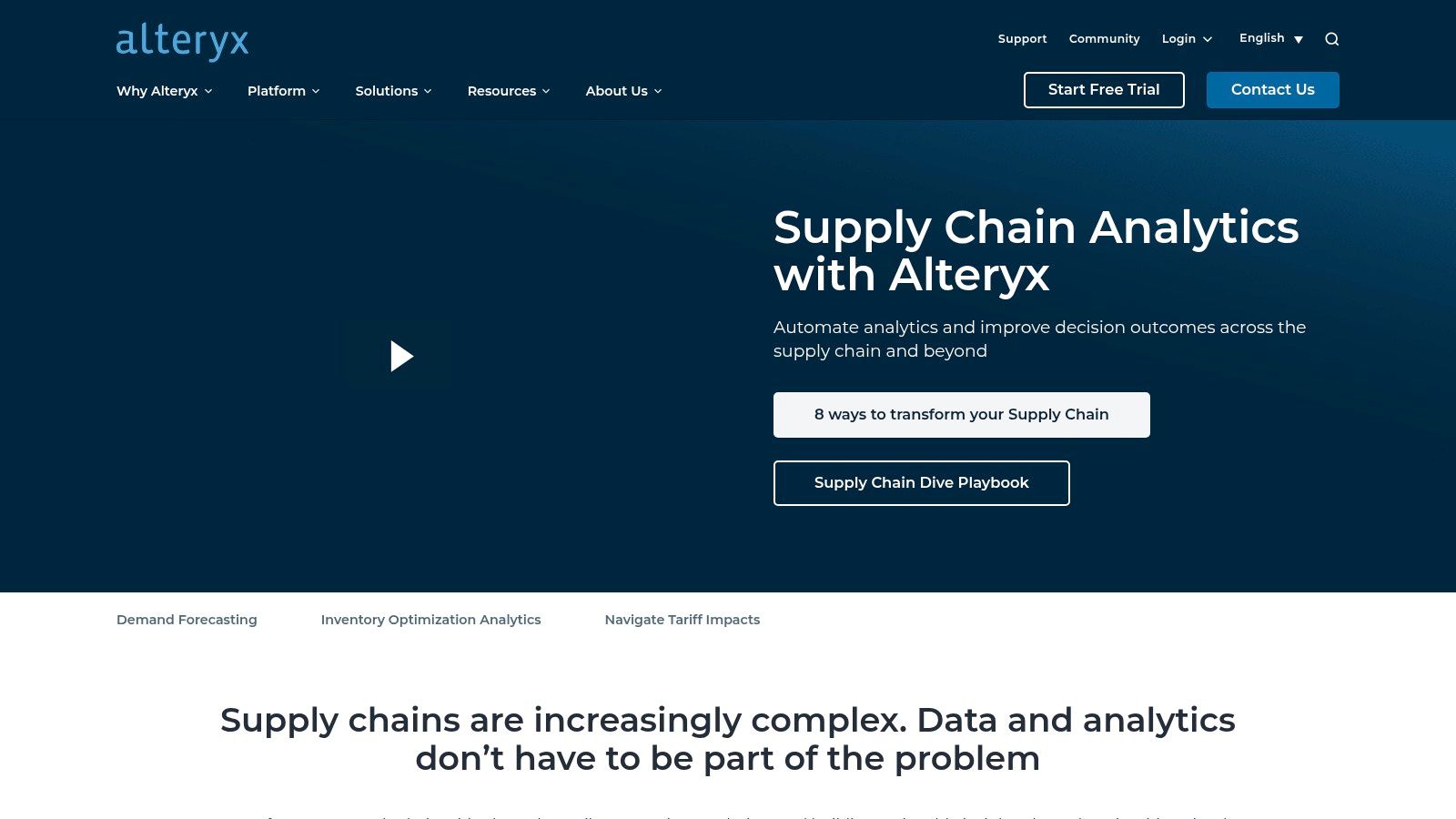
Unlike platforms that require separate tools for data blending and visualization, Alteryx allows for the creation of rapid, shareable dashboards and insights within the same ecosystem. This integrated approach significantly improves accuracy in supplier management and enhances collaboration across departments through its automated workflows.
Platform Breakdown
Feature | Details |
|---|---|
Ideal Use Case | Organizations needing to automate complex data blending and analytics for demand forecasting, inventory optimization, and logistics planning. |
Key Advantage | Code-free workflow builder that accelerates the entire analytics lifecycle, from data prep to insight delivery. |
Pricing | Custom pricing based on user needs and deployment scale. A free trial is available. |
Limitation | The platform’s comprehensive nature can present a learning curve for complete beginners. Its pricing model may also be a significant investment for smaller businesses. |
3. Supplier.io
Supplier.io carves out a specific niche within the analytics landscape by focusing on supplier diversity and responsible sourcing. It transforms procurement data into actionable insights, enabling organizations to track and report on their supply chain composition with precision. This platform is one of the most effective supply chain analytics tools for companies prioritizing ethical and diverse supplier management, automating otherwise time-consuming reporting tasks.
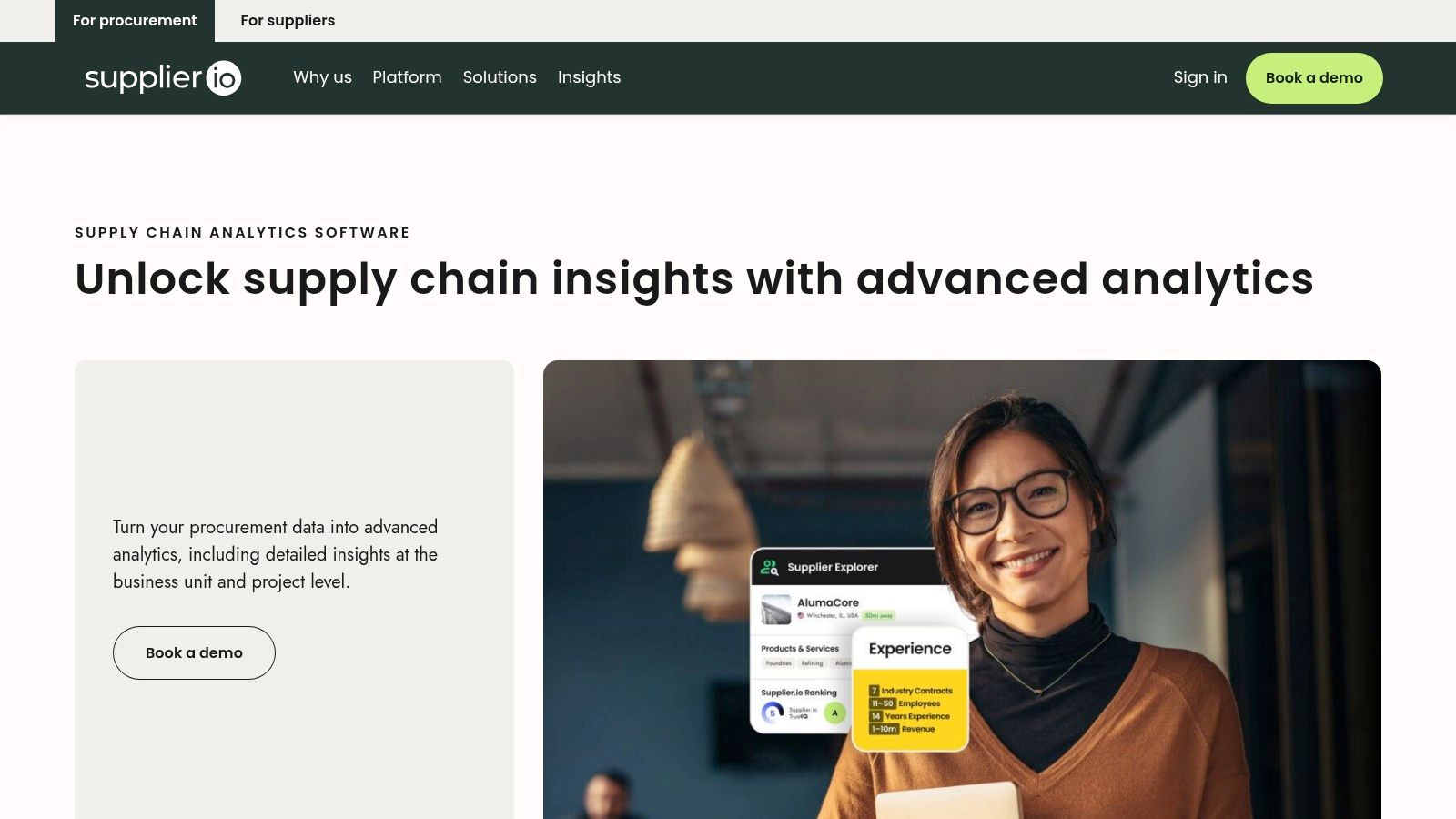
Unlike general-purpose analytics platforms, Supplier.io provides specialized dashboards and centralized tracking tailored to supplier diversity initiatives. Its user-friendly interface allows non-technical users to quickly analyze supplier data, ensuring accuracy and enhancing decision-making. The platform's emphasis on visibility and tracking also makes it a valuable asset for overall supply chain integrity, as you can explore further in this guide on top visibility tools.
Platform Breakdown
Feature | Details |
|---|---|
Ideal Use Case | Companies focused on building and reporting on supplier diversity programs and responsible sourcing initiatives. |
Key Advantage | Significant time savings on compliance and diversity reporting through automated, specialized dashboards. |
Pricing | Custom pricing based on organizational size and specific module requirements. A demo is available upon request. |
Limitation | Its specialized focus on supplier diversity means it may not meet the needs of organizations requiring broader analytics capabilities like demand or logistics planning. |
4. Microsoft Power BI
Microsoft Power BI has become a cornerstone for businesses seeking accessible yet powerful business intelligence. Its strength in the supply chain sector comes from its ability to connect to over 120 data sources, allowing for a unified view of logistics, inventory, and supplier performance. This makes it one of the most versatile supply chain analytics tools for creating real-time, interactive dashboards that can track everything from shipment statuses to warehouse efficiency.
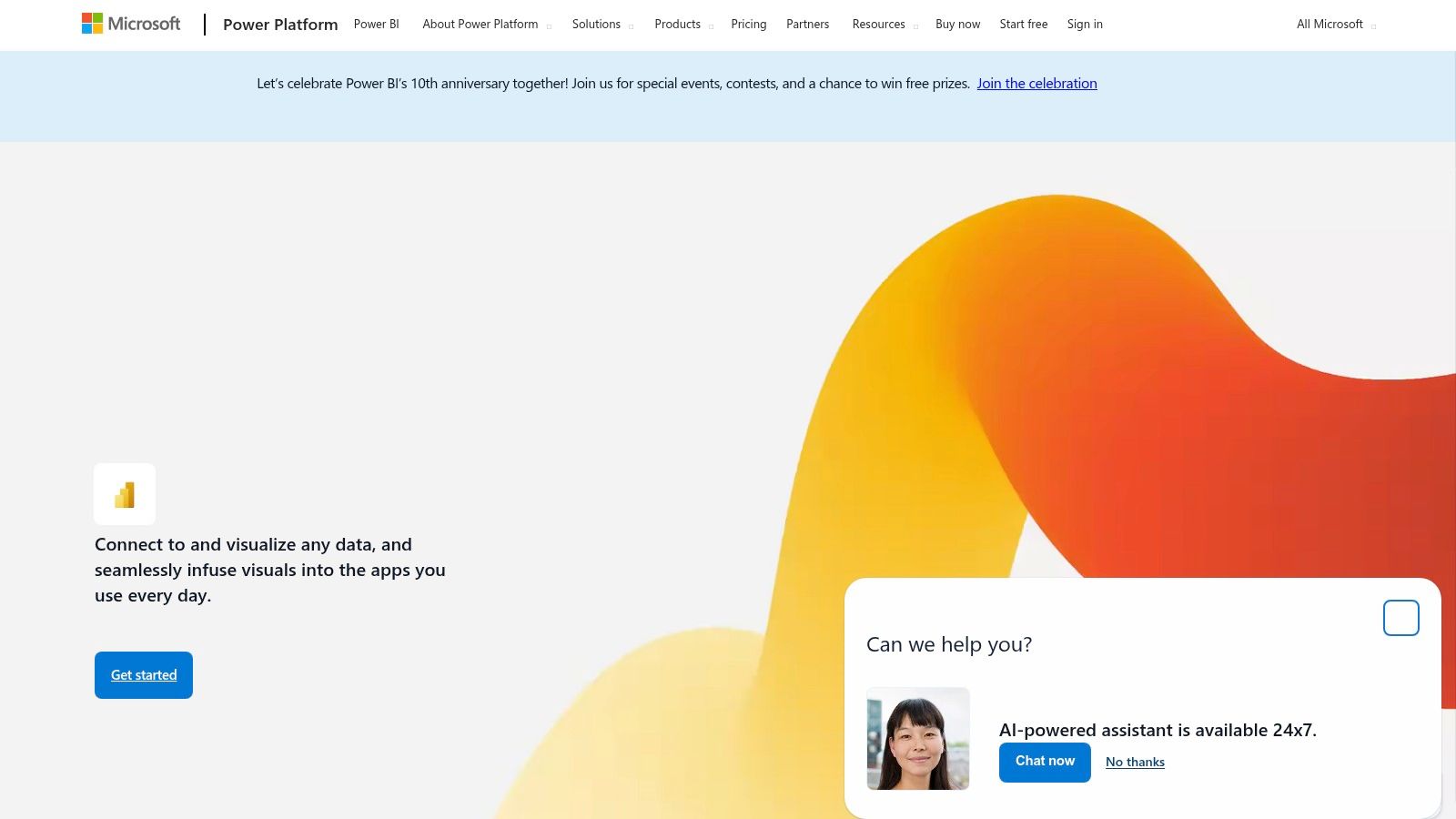
The platform empowers supply chain managers to perform self-service data preparation and analysis with its intuitive drag-and-drop interface. This seamless experience helps teams quickly turn data into actionable insights without heavy reliance on IT departments, fostering a data-driven culture across the organization. Its scalability ensures that both small businesses and large enterprises can leverage its capabilities effectively.
Platform Breakdown
Feature | Details |
|---|---|
Ideal Use Case | Businesses of all sizes needing a cost-effective, scalable tool for creating live, consolidated dashboards for supply chain monitoring. |
Key Advantage | Extensive integration with the Microsoft ecosystem and a vast number of data connectors, combined with a user-friendly interface. |
Pricing | A free version is available for individual use. Paid plans (Power BI Pro and Premium) offer more features and collaboration options. |
Limitation | Performance can sometimes be impacted when processing extremely large datasets. Advanced DAX functions require a significant learning curve for new users. |
Website: https://powerbi.microsoft.com/
5. Coupa
Coupa provides a cloud-native Business Spend Management (BSM) platform that brings procurement, invoicing, and supply chain functions under one unified system. It excels at translating vast amounts of spending data into actionable intelligence, using AI to give enterprises a clear view of their entire supply chain's financial health. This makes it one of the most effective supply chain analytics tools for organizations focused on optimizing cash flow and mitigating supplier risk.
By integrating transactional processes with advanced analytics, Coupa allows teams to move beyond simple cost-cutting to strategic sourcing and supplier management. Its collaborative features empower businesses to work more closely with their suppliers, ensuring compliance and improving overall resilience against disruptions.
Platform Breakdown
Feature | Details |
|---|---|
Ideal Use Case | Large enterprises requiring end-to-end visibility and control over global spend to improve financial efficiency and manage supplier relationships. |
Key Advantage | AI-powered insights that analyze community-wide spending data to provide prescriptive recommendations for sourcing and risk management. |
Pricing | Custom pricing based on modules selected and enterprise scale. Does not typically offer a free trial. |
Limitation | The comprehensive platform can be complex to implement and may have a steep learning curve. Its pricing structure is often prohibitive for smaller businesses. |
Website: https://www.coupa.com/
6. Anaplan
Anaplan is a cloud-based planning platform that excels at connecting disparate business functions, from finance and sales to the supply chain. It enables organizations to move beyond siloed spreadsheets and create a single, synchronized environment for collaborative planning and decision-making. Its strength lies in enabling real-time scenario modeling, which makes it one of the more dynamic supply chain analytics tools for testing the impact of potential disruptions.
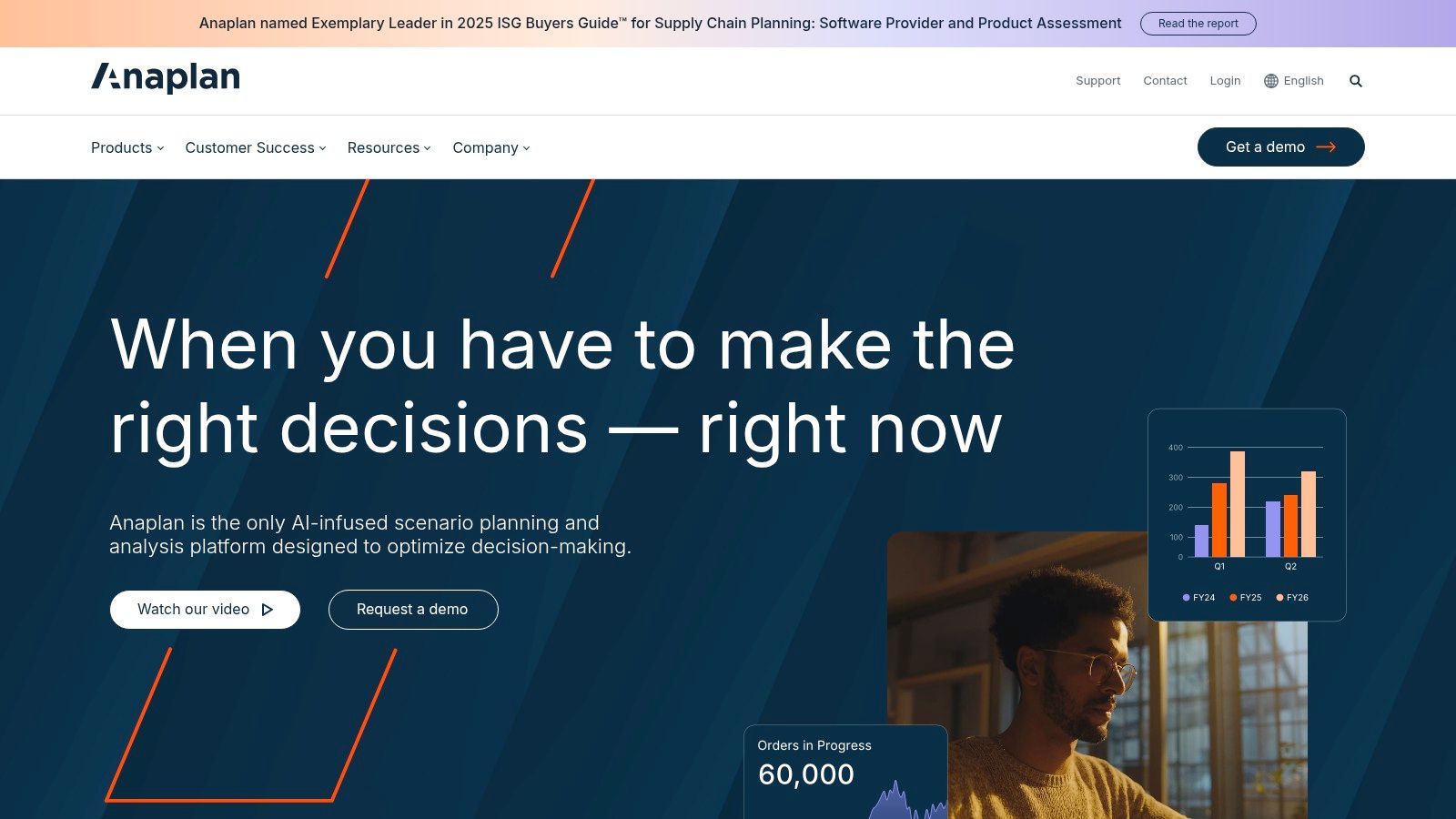
The platform's proprietary PlanIQ forecasting engine integrates machine learning and statistical calculations to generate more accurate demand and supply predictions. Unlike static analytics tools, Anaplan uses visual model maps to help users understand complex interdependencies across the supply network, facilitating better alignment between strategic goals and operational execution. This approach fosters enhanced collaboration and network-wide visibility.
Platform Breakdown
Feature | Details |
|---|---|
Ideal Use Case | Large enterprises looking to synchronize demand planning, supply planning, and sales and operations planning (S&OP) in a single, connected platform. |
Key Advantage | Powerful real-time scenario modeling and a highly collaborative environment that breaks down data silos between departments and external partners. |
Pricing | Custom quote-based pricing. Pricing information is not publicly available on the website. |
Limitation | The platform's extensive capabilities can be complex, often requiring specialized training or implementation support for optimal use. |
Website: https://www.anaplan.com/
7. Blue Yonder
Blue Yonder offers a comprehensive, AI-driven suite designed for end-to-end supply chain management, from planning and execution to fulfillment. Its strength lies in integrating generative AI and a unified data model to provide predictive insights and automate complex decisions. This makes it one of the most forward-thinking supply chain analytics tools for large-scale manufacturers and retailers aiming to build a more resilient and autonomous supply chain.
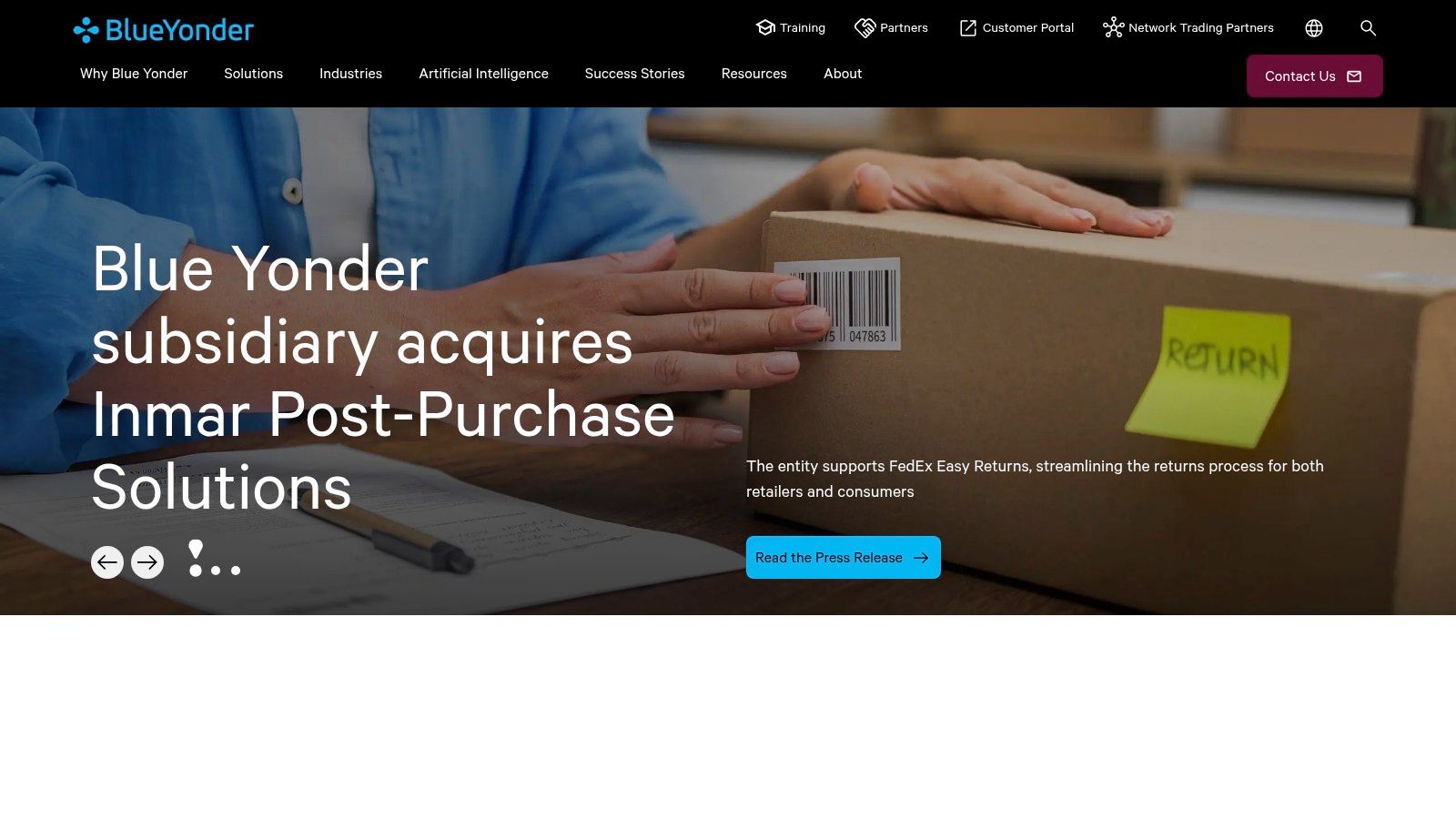
The platform’s Luminate Cognitive Platform serves as the intelligent core, connecting data across the entire ecosystem to enhance demand forecasting, inventory optimization, and logistics. Unlike more niche tools, Blue Yonder provides a single, cohesive environment with domain-enriched UI components, ensuring that insights are not only powerful but also accessible and relevant to specific operational roles.
Platform Breakdown
Feature | Details |
|---|---|
Ideal Use Case | Enterprise-level manufacturers and retailers requiring an integrated platform for demand forecasting, inventory optimization, and automated logistics planning. |
Key Advantage | Combines a unified data model with advanced AI and generative AI capabilities for predictive, autonomous supply chain operations. |
Pricing | Pricing is customized based on specific modules, company size, and implementation needs. Information is not publicly available. |
Limitation | The platform’s extensive capabilities can result in a complex and costly implementation, making it less suitable for smaller businesses without dedicated IT resources. |
Website: https://blueyonder.com/
8. Kinaxis
Kinaxis provides a robust supply chain planning and analytics solution focused on concurrent planning, which allows all business functions to work from a single, synchronized plan. Its standout feature is the ability to run real-time "what-if" scenarios, enabling organizations to model potential disruptions and proactively develop response strategies. This makes it an essential platform for companies operating in volatile markets that require high levels of agility and resilience.
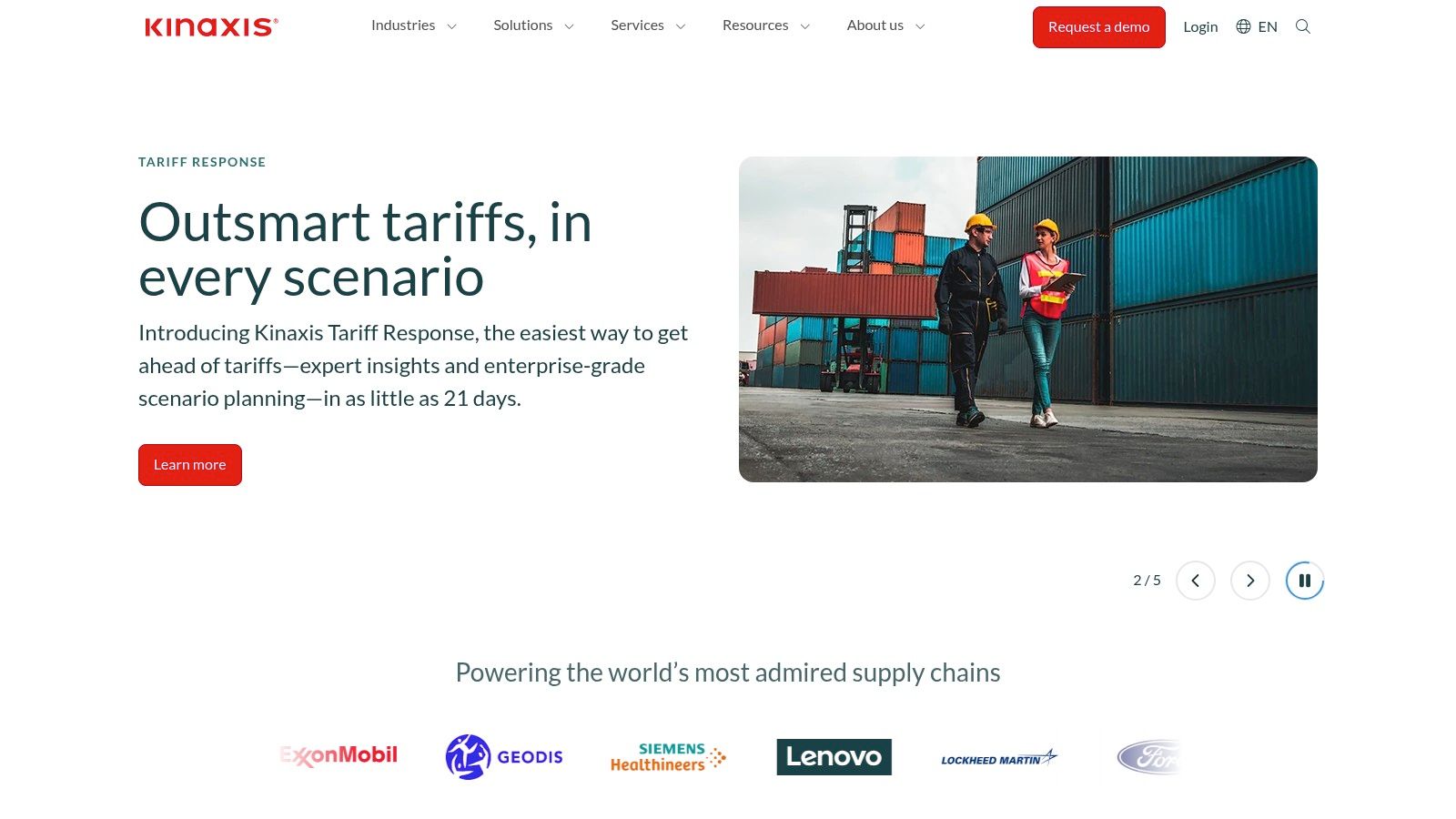
Unlike many traditional systems that operate in disconnected silos, Kinaxis uses end-to-end synchronization to provide a unified view of the entire supply chain. Its AI-driven insights help automate decision-making and optimize performance, from demand forecasting to inventory management. This comprehensive approach is one of the proven ways to improve supply chain efficiency fast, making Kinaxis one of the top-tier supply chain analytics tools for large enterprises.
Platform Breakdown
Feature | Details |
|---|---|
Ideal Use Case | Large enterprises that need to manage complex global supply chains and require advanced scenario simulation for risk mitigation. |
Key Advantage | Concurrent planning capabilities that synchronize data across all departments for a single source of truth, enhancing agility and resilience. |
Pricing | Custom pricing based on specific business requirements and implementation scale. |
Limitation | The platform's complexity and significant financial investment make it less suitable for small to mid-sized businesses. It often requires dedicated training for effective use. |
Website: https://www.kinaxis.com/
9. Tableau
Tableau excels as a premier interactive data visualization and business intelligence platform, empowering supply chain professionals to transform complex datasets into clear, actionable insights. It specializes in visual storytelling, allowing users to build dynamic dashboards that track everything from supplier performance to logistics costs. This visual-first approach makes Tableau one of the most intuitive supply chain analytics tools for teams that need to explore data and communicate findings effectively.
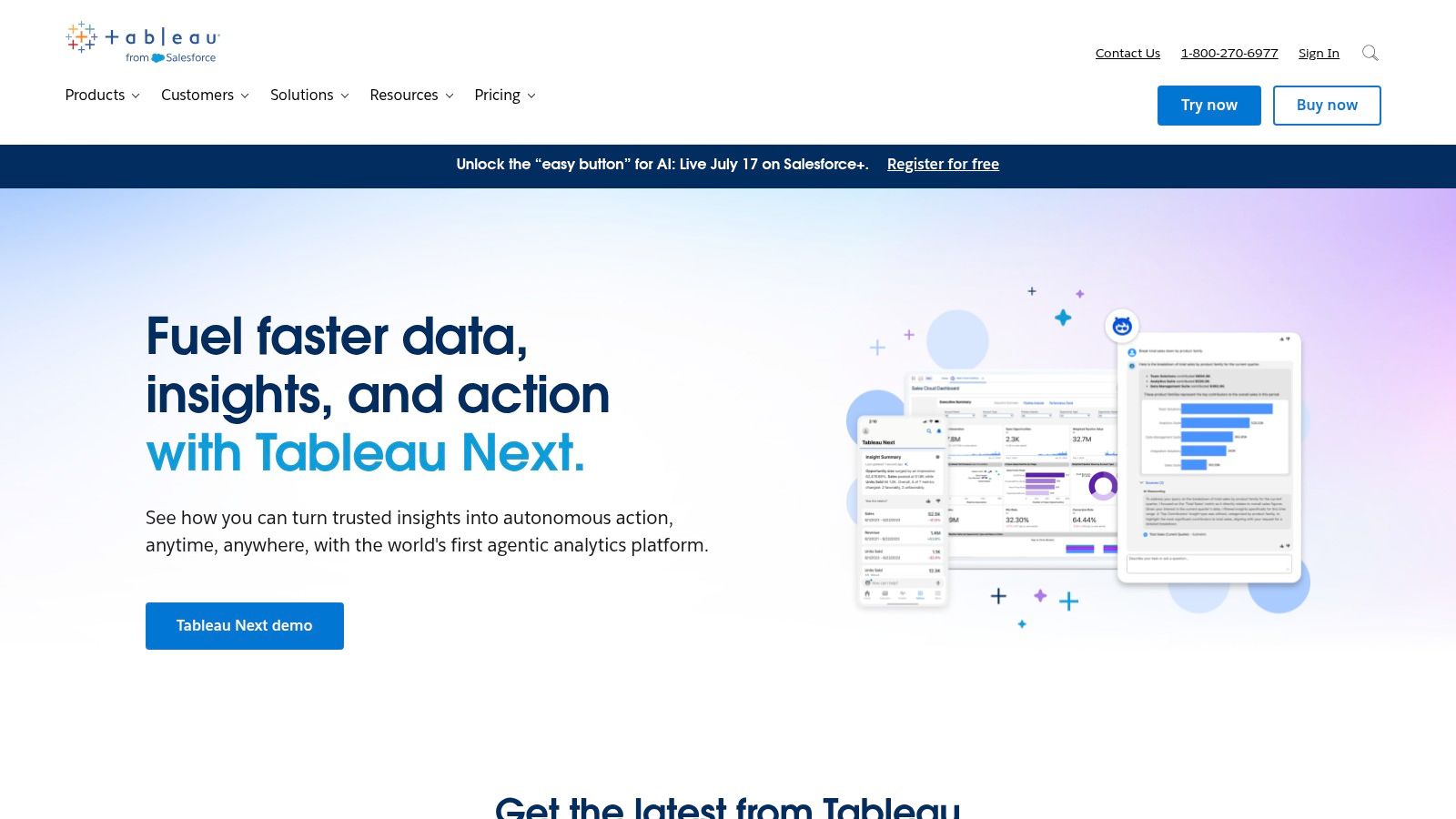
Unlike tools focused purely on data processing, Tableau's strength lies in making analytics accessible to a broader audience. Its forecasting, predictive modeling, and geospatial analytics features are invaluable for identifying trends in demand, optimizing shipping routes, and mitigating risks. The platform's scalability ensures it can support both small businesses and large enterprises looking to cultivate a data-driven culture across their supply chain operations.
Platform Breakdown
Feature | Details |
|---|---|
Ideal Use Case | Companies aiming to create interactive dashboards for monitoring KPIs, performing what-if analysis, and sharing supply chain insights across departments. |
Key Advantage | Unmatched data visualization capabilities and a user-friendly interface that simplifies the exploration of complex supply chain data. |
Pricing | Tiered subscription pricing based on user roles (Creator, Explorer, Viewer). A free trial is available. |
Limitation | While powerful, performance can slow down with extremely large datasets. Mastering its more advanced features often requires dedicated training. |
Website: https://www.tableau.com/
10. GoodData
GoodData delivers a powerful, composable business intelligence platform designed for embedding analytics directly into existing business applications and workflows. Its key differentiator is its API-first, developer-friendly architecture, which allows companies to build and integrate custom analytics solutions without being locked into a monolithic system. For supply chain managers, this means creating tailored dashboards for supplier performance, logistics tracking, and inventory levels that feel like a native part of their operational software.
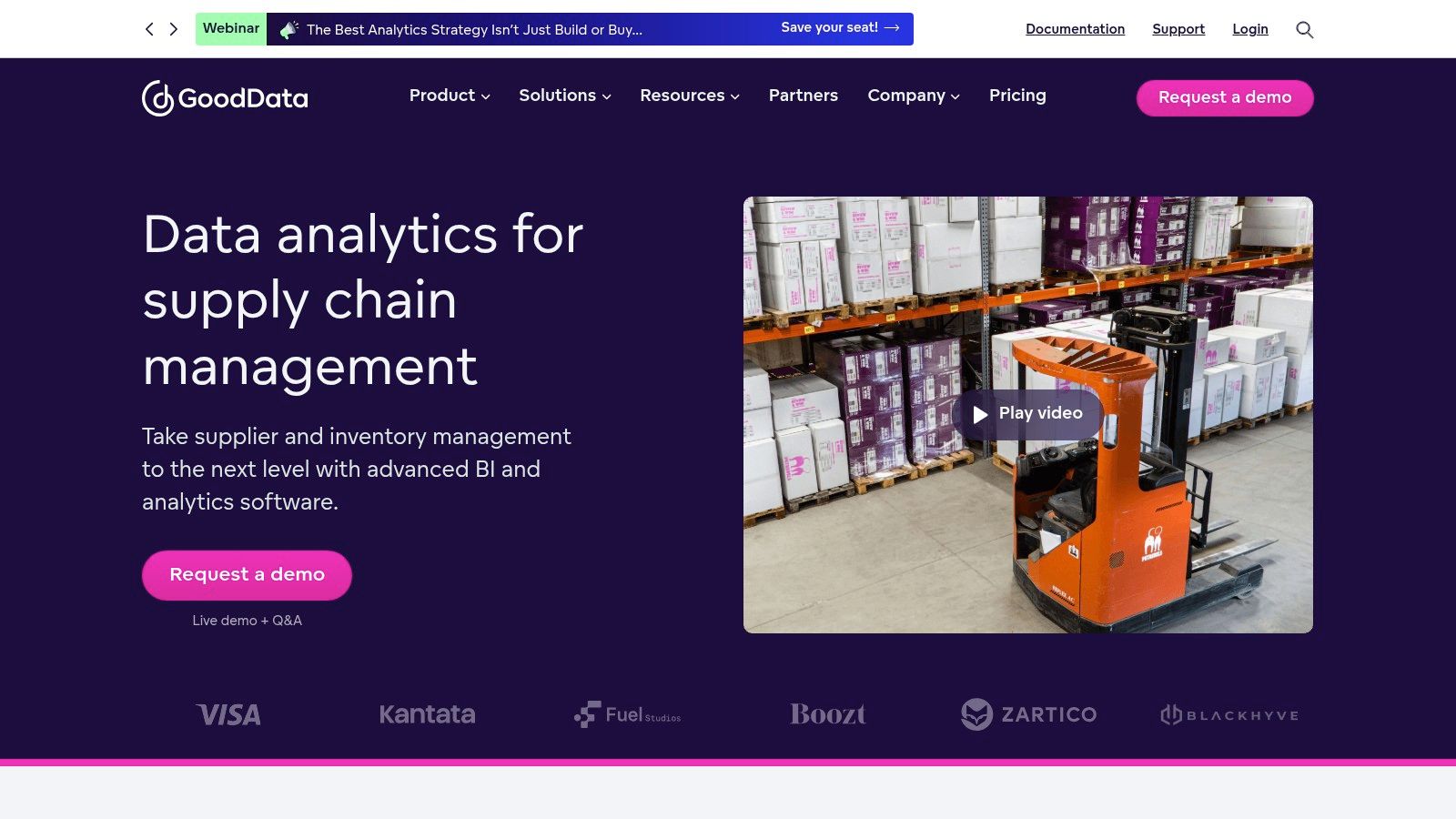
Unlike many out-of-the-box solutions, GoodData excels at providing the building blocks for highly secure and scalable analytics. Its emphasis on open APIs and declarative SDKs makes it one of the most flexible supply chain analytics tools for technology companies or large enterprises needing to infuse data insights across their entire ecosystem, ensuring robust governance and accessibility compliance.
Platform Breakdown
Feature | Details |
|---|---|
Ideal Use Case | Enterprises wanting to embed custom, secure, and scalable supply chain analytics directly into their existing applications and operational systems. |
Key Advantage | API-first, composable architecture allows for immense flexibility and seamless integration into any tech stack, with strong governance features. |
Pricing | Custom pricing based on deployment and usage. A free trial is available. |
Limitation | The platform’s developer-centric nature may require significant technical expertise for implementation and full utilization, making it less suitable for teams without dedicated IT support. |
11. Raptech AI
Raptech AI specializes in streamlining procurement and supplier management through its AI-driven automation and analytics solutions. The platform focuses on eliminating manual tasks and enhancing supplier collaboration by automating key processes from onboarding to performance tracking. This targeted approach makes it a valuable asset for companies looking to gain efficiency and visibility specifically within the procurement lifecycle.
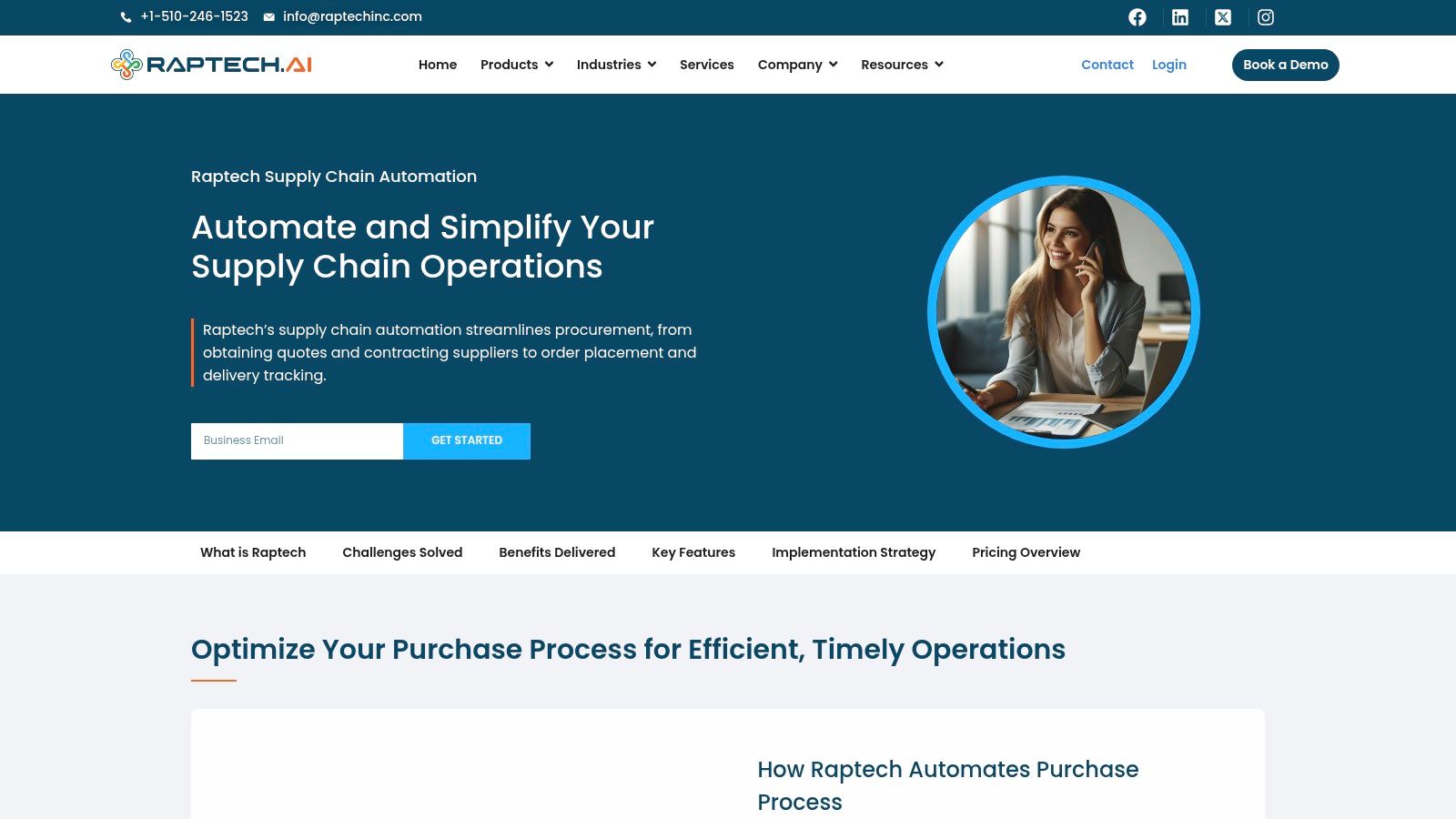
Unlike broader analytics suites, Raptech AI hones in on the supplier ecosystem, offering real-time reporting that helps businesses optimize spending and reduce operational friction. By transforming procurement into a more data-centric function, it stands out as one of the more specialized supply chain analytics tools for organizations aiming to achieve significant cost savings and stronger supplier relationships through intelligent automation.
Platform Breakdown
Feature | Details |
|---|---|
Ideal Use Case | Companies aiming to automate procurement workflows, streamline supplier onboarding, and improve overall supplier relationship management. |
Key Advantage | A strong focus on AI-powered process automation for procurement, leading to enhanced operational efficiency and cost reductions. |
Pricing | Custom pricing based on business needs and implementation scope. Pricing information is not publicly listed. |
Limitation | The platform's specialized nature may require customization to fit unique or complex business processes. A lack of transparent pricing makes initial evaluation difficult. |
12. SafetyCulture (iAuditor)
SafetyCulture, formerly known as iAuditor, offers a unique angle on supply chain management by emphasizing safety, quality control, and operational efficiency. Its mobile-first platform empowers teams on the ground to conduct inspections, report issues, and capture critical data in real time. This approach transforms frontline observations into actionable insights, making it a valuable resource among supply chain analytics tools for organizations focused on compliance and risk mitigation.
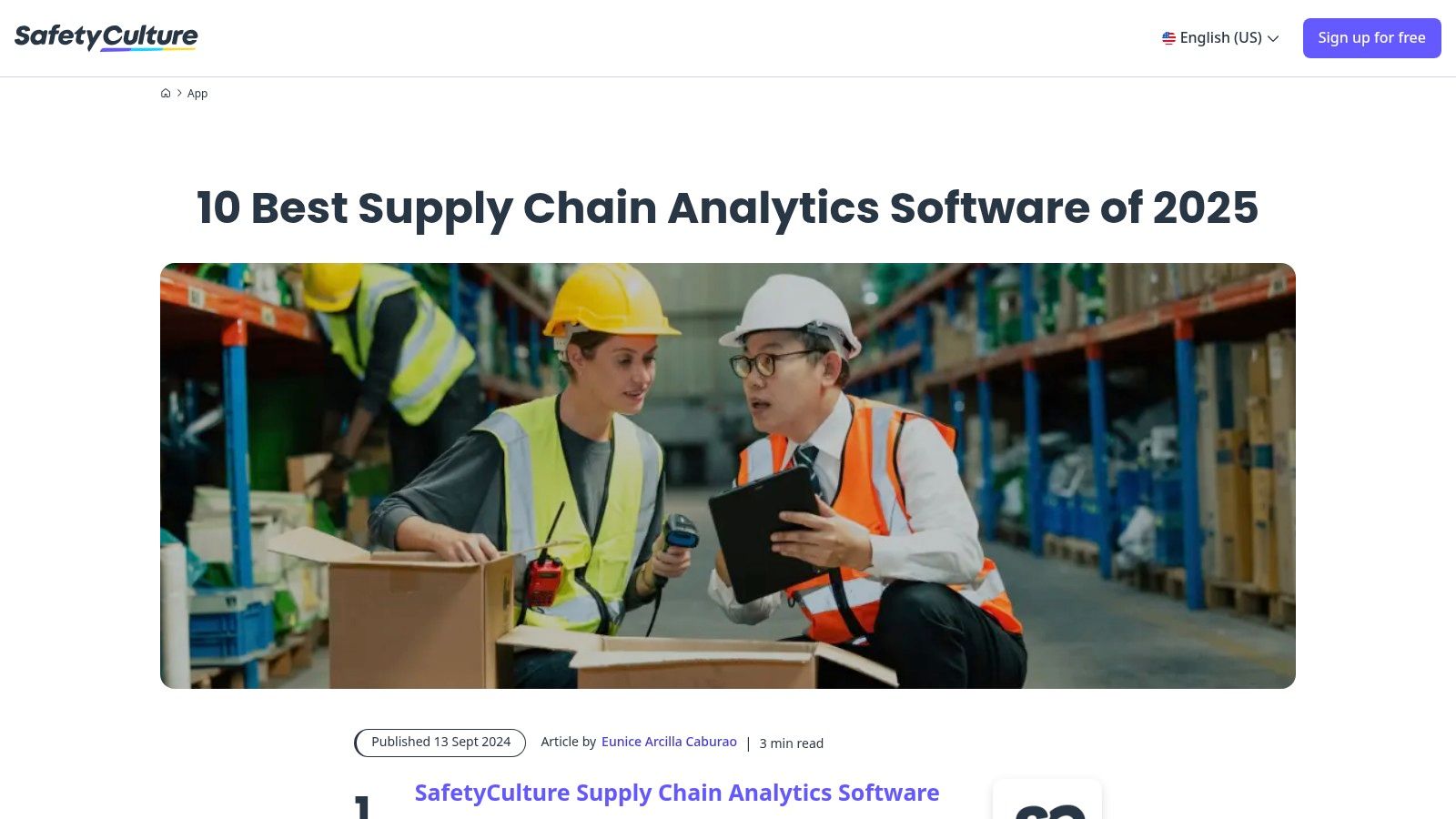
Unlike traditional analytics platforms that focus solely on high-level logistics, SafetyCulture provides granular visibility into day-to-day operations. By digitizing checklists and standard operating procedures, it helps businesses track performance metrics, identify recurring problems in the supply chain, and ensure that quality standards are met consistently from origin to destination. The platform excels at connecting disparate data points from the field, including photos and sensor data, to a central analytics dashboard.
Platform Breakdown
Feature | Details |
|---|---|
Ideal Use Case | Companies needing to enforce safety and quality standards across their supply chain, from supplier audits to warehouse operations and final-mile delivery. |
Key Advantage | Mobile-first design that facilitates real-time data collection from any point in the supply chain, improving operational visibility and compliance. |
Pricing | Offers a free plan for small teams. Paid plans (Premium and Enterprise) are priced per user, per month, with custom quotes for larger organizations. |
Limitation | Its primary focus is on operational quality and safety, so it may lack the advanced demand forecasting or network optimization features of more specialized tools. |
Supply Chain Analytics Tools Comparison
Solution | Core Features/Capabilities | User Experience & Quality ★ | Value Proposition 💰 | Target Audience 👥 | Unique Selling Points ✨ |
|---|---|---|---|---|---|
🏆 Flow Genius | Customized smart automation; Zapier & custom scripting | ★★★★★ Hands-on support & seamless integration | Free consultation; tailored pricing | Medium to large businesses with complex workflows | Bespoke workflows; multi-sector expertise; Data Advisory |
Alteryx | Drag-and-drop analytics; AI integration | ★★★★ User-friendly, some training needed | Premium pricing | Supply chain analysts and data professionals | Rapid dashboard creation; automated reporting |
Supplier.io | Supplier diversity focus; automated reporting dashboards | ★★★★ Intuitive for non-technical users | Moderate, less customization | Procurement and supplier diversity teams | Centralized supply chain tracking; time savings |
Microsoft Power BI | 120+ data source integrations; real-time dashboards | ★★★★ Scalable, user-friendly | 💰 Free version + paid tiers | Businesses of all sizes | Extensive connectors; self-service analytics |
Coupa | AI-driven spend analysis; supplier risk management | ★★★★ Comprehensive & scalable | Custom pricing | Large enterprises | Spend management; real-time cash flow insights |
Anaplan | PlanIQ forecasting; visual model maps | ★★★★ Advanced analytics, needs training | Pricing on request | Businesses requiring detailed supply chain planning | Network-wide collaboration; scenario evaluation |
Blue Yonder | AI integration; unified data model | ★★★★ Advanced, complex implementation | Pricing on request | Manufacturers & retailers | Generative AI; domain-enriched UI |
Kinaxis | Real-time insights; scenario simulation | ★★★★ Effective but complex | Significant investment | Large enterprises focused on risk & resilience | End-to-end synchronization; AI-driven insights |
Tableau | Data storytelling; forecasting; geospatial analytics | ★★★★ Strong visualization; training required | Mid-tier pricing | Various business sizes | Interactive dashboards; predictive modeling |
GoodData | Open APIs; security & governance | ★★★★ Flexible but technical | Pricing on request | Businesses needing secure BI & integrations | Security features; flexible deployment |
Raptech AI | Procurement automation; real-time reporting | ★★★★ Efficient but may need customization | Pricing on request | Procurement teams | AI-driven procurement optimization |
SafetyCulture (iAuditor) | Real-time tracking; IoT integration | ★★★★ Mobile-first, data-rich | Mid-tier pricing | Industries prioritizing safety & quality | IoT synergy; mobile access |
Final Thoughts
Navigating the expansive landscape of supply chain analytics tools can feel like a monumental task, but the potential rewards are equally significant. As we've explored, the right platform can transform a reactive, opaque supply chain into a proactive, transparent, and highly optimized engine for business growth. From dedicated enterprise-grade solutions like Anaplan and Blue Yonder to versatile business intelligence platforms like Microsoft Power BI and Tableau, the market offers a tool for nearly every specific need and organizational scale.
The key takeaway is that there is no single "best" solution for everyone. Your ideal choice hinges on a careful evaluation of your unique operational context, existing technology stack, and strategic objectives. A small roofing contractor has vastly different analytics needs than a global technology company, and the tools reflect this diversity. This guide was designed to move beyond surface-level feature lists and provide a strategic framework for your decision-making process.
Your Path to Implementation
Choosing a tool is only the first step; successful implementation is where the real value is unlocked. To ensure a smooth transition and maximize your return on investment, consider the following actionable steps:
Define Your Core Problems: Before you even look at a demo, clearly articulate the top 3-5 supply chain challenges you need to solve. Are you battling stockouts? Struggling with supplier risk? Drowning in manual reporting? Let these problems guide your search.
Assess Integration Capabilities: Your supply chain analytics tool cannot exist in a vacuum. Scrutinize its ability to connect with your existing ERP, CRM, and warehouse management systems. Look for native integrations or robust API support for platforms like Zapier or Make.com to avoid creating data silos.
Start with a Pilot Program: Resist the urge to deploy a new system company-wide at once. Identify a single, high-impact area for a pilot project, such as inventory forecasting for a specific product line or supplier performance tracking for a key region. This approach minimizes risk and helps build internal buy-in.
Prioritize User Adoption: The most powerful tool is useless if your team doesn't use it. Involve end-users, from logistics directors to warehouse managers, early in the selection process. Focus on platforms with intuitive interfaces and provide comprehensive training to ensure the tool becomes an integral part of their daily workflow.
Ultimately, investing in the right supply chain analytics tools is an investment in resilience, efficiency, and a powerful competitive advantage. By leveraging data-driven insights, you can anticipate disruptions, delight customers, and build a supply chain that is not just a cost center, but a strategic asset ready for the challenges of tomorrow.
If you're looking to bridge the gaps between your analytics platforms and operational systems, automation is key. Flow Genius specializes in creating custom, powerful workflows that connect your apps, automate processes like CRM updates or outbound communication, and ensure the insights from your analytics tools trigger real-world actions. Explore how seamless integration can amplify the power of your supply chain data at Flow Genius.